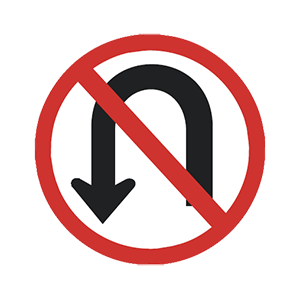2025 Kansas Permit Test 22
The following questions are from real DMV written tests. These are some of the actual permit questions you will face in Kansas. Each permit practice test question has three answer choices. Select one answer for each question and select "grade this section." You can find this button at the bottom of the drivers license quiz. For a complete list of questions and answers for Kansas please visit https://cheat-sheets.dmv-written-test.com/en/kansas/car.
Number of Tests
Number of Question
Passing Score
17. If you park facing uphill where there is no curb, set the parking brake and:
Explanation
When parking uphill on a road that does not have a curb, your front wheels should be turned to the right (toward the edge of the road). This will ensure that the vehicle will roll off of the road if the brakes fail.
18. You must yield the right-of-way to an emergency vehicle that is using its siren and flashing lights by:
Explanation
You must yield the right-of-way to any emergency vehicle that is using its siren and flashing lights. Do this by driving to the right edge of the road and stopping, taking care not to stop in an intersection. You may move again after the emergency vehicle has passed.
19. The best way to avoid a dangerous situation while driving is to:
Explanation
Always be aware of what is happening around your vehicle. Constantly observing your surroundings to the front, sides, and rear of your vehicle will help you see problems that may require you to change speed or roadway position.
21. You are entering a freeway. Check traffic on the freeway by:
Explanation
When entering any roadway, you must be aware of traffic conditions. Use your side mirror and look over your shoulder to help you see and anticipate traffic when entering a freeway.
22. If you cannot see farther than 100 feet ahead of your vehicle due to rain, snow, blowing dust, smoke, or thick fog, then you are unable to safely drive faster than:
Explanation
Adverse weather conditions can rapidly reduce visibility. If you cannot see farther than 100 feet ahead of your vehicle due to rain, snow, blowing dust, smoke, or thick fog, you cannot safely drive faster than 30 mph.
23. To avoid hydroplaning while driving in rainy conditions, you should:
Explanation
When driving too quickly in wet conditions, your tires may lose all contact with the road surface. Loss of traction will cause the vehicle to ride on top of the water, which is called "hydroplaning." The best way to prevent this from happening is to drive more slowly in rainy or wet conditions than you would when driving during ideal weather conditions.
24. To be able to turn quickly, your hands must be:
Explanation
Both hands should be placed on opposite sides of the steering wheel. This position is comfortable and promotes safe turning on high-speed roadways.
25. What does this road sign mean?

Explanation

